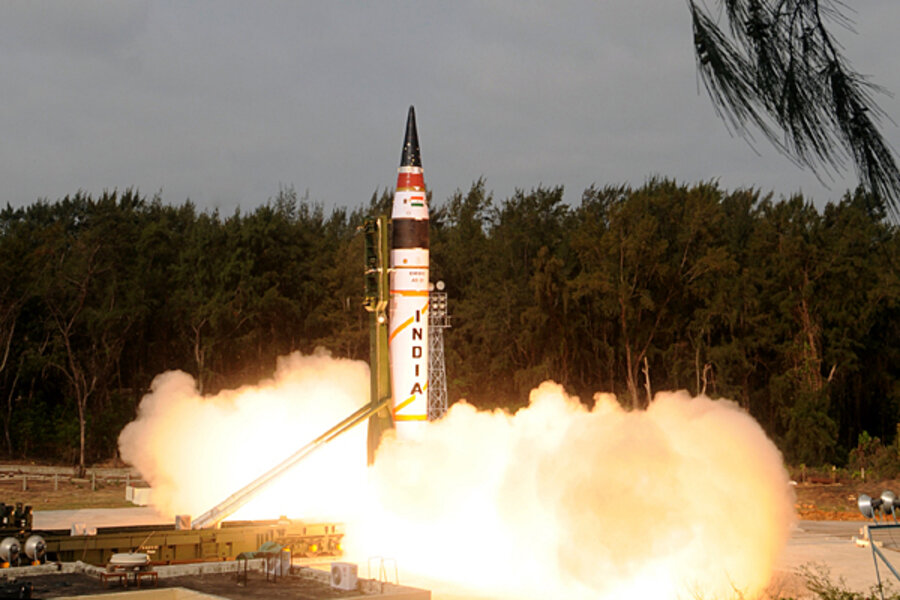Ritual Aggression: India and Pakistan's missile tests, following peace talks
Though the tenor of the relationship between India and Pakistan is improving, they are still prone to quarrel – if mainly out of habit.
On Wednesday, Pakistan successfully tested its new and improved Hatf Shaheen 1-A ballistic missile, which is capable of carrying the nuclear weapons that Pakistan has demonstrated it is capable of producing. The Pakistan missile test comes just days after India tested its own improved ballistic missile, the Agni-V, which is capable of carrying nuclear payloads as far away as Beijing or Shanghai.
But the fact that these tests are seen by the news media of each country as no big deal is an indication of how much the political mood in each country has changed over the past decade.
These tests follow an extraordinary set of meetings between the president of Pakistan, Asif Ali Zardari, and Indian Prime Minister Manmohan Singh in Delhi earlier this month, in which the two nations pledged to increase trade ties and to fight against extremism.
While these missile testsmight have seemed to be a setback in earlier times, they have now become a kind of kabuki theater of virility, separate from any political discourse. Light up one of those multimillion-dollar candles, and you can demonstrate to the world that your nation is not to be messed with. You can also know that your neighbor will quickly follow your test with one of his own.
(There is a second cheaper test of virility, of course. It’s called cricket.)
Retired Pakistan army Gen. Talat Masood, now an independent analyst, says that these tests have now become a predictable part of South Asian politics.
"This is what has been happening over the past few years," said Masood in an interview with the Associated Press. "The tests by Pakistan and India follow each other to show that their programs are robust."
After India conducted underground nuclear tests in May 1998, and Pakistan followed up with its own nuclear tests later that same month, relations between the two rival countries became distinctly frosty. Attempts to patch up relations were made, such as at a meeting of Pakistan’s then-President Pervez Musharraf and India’s then-Prime Minister Atul Behari Vajpayee in Agra in July 2001, but those talks collapsed in acrimony.
India and Pakistan certainly have reasons to be annoyed with each other. They both claim to be the rightful owners of the Himalayan mountain region called Kashmir, but neither has the military capability or stomach to take away the portion of Kashmir occupied by the other. As a Muslim majority region, Kashmir should have been handed over to Pakistan at the time of partition in 1947, the Pakistani government reasons, but India counters that the princely leader of that region decided to opt for Indian rule instead.
Wars have been fought over this rocky turf, but in recent years, Pakistan has turned to a set of extremist militant groups, such as Lashkar-e Taiba, to act as its proxies. Initially, these Pakistani based terror groups focused on Kashmir, but in Nov. 2008, they struck India’s financial capital of Mumbai, killing more than 100. Pakistan denied any link to the Mumbai attack, but the surviving member of the attack team admitted being a member of Lashkar-e Taiba, and intercepted phone calls from the attack group were made to contacts in Pakistan, where Lashkar-e Taiba operates openly.
With these elements still in play – disputes over Kashmir, use of terrorist proxies – it’s striking that India treats Pakistan in such a light manner. Perhaps the main reason has to do with economics. India’s fast-growing economy has left its rival in the dust, allowing India to focus on a bigger rival, China. And if India believes that the powerful US military has its back – actively hunting extremists in the mountains of Afghanistan at least until 2014 – then perhaps it can rest assured that Pakistan won’t be able to use extremist proxies – or non-state actors, as Pakistan calls them – for much longer.





